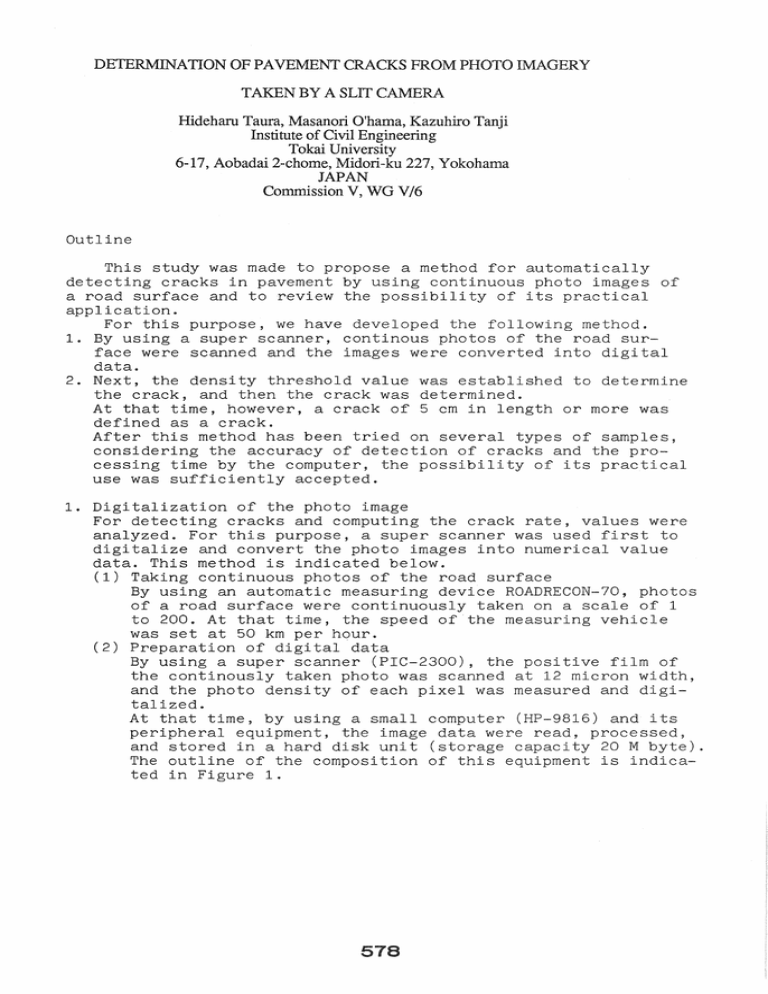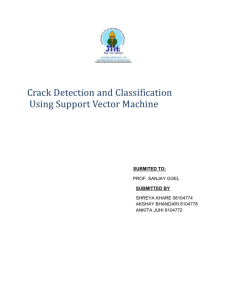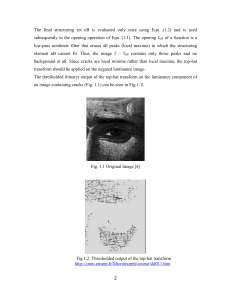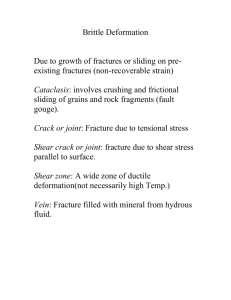DETERMINATION OF PA VEMENT CRACKS FROM PHOTO IMAGERY
advertisement

DETERMINATION OF PAVEMENT CRACKS FROM PHOTO IMAGERY
TAKEN BY A SLIT CAMERA
Hideharu Taura, Masanori O'hama, Kazuhiro Tanji
Institute of Civil Engineering
Tokai University
6-17, Aobadai 2-chome, Midori-ku 227, Yokohama
JAPAN
Commission V, WG V/6
Outline
This study was made to propose a method for automatically
detecting cracks in pavement by using continuous photo images of
a road surface and to review the possibility of its practical
application.
For this purpose, we have developed the following method.
1. By using a super scanner, continous photos of the road surface were scanned and the images were converted into digital
data.
2. Next, the density threshold value was established to determine
the crack, and then the crack was determined.
At that time, however, a crack of 5 cm in length or more was
defined as a crack.
After this method has been tried on several types of samples,
considering the accuracy of detection of cracks and the processing time by the computer, the possibility of its practical
use was sufficiently accepted.
1. Digitalization of the photo image
For detecting cracks and computing the crack rate, values were
analyzed. For this purpose, a super scanner was used first to
digitalize and convert the photo images into numerical value
data. This method is indicated below.
(1) Taking continuous photos of the road surface
By using an automatic measuring device ROADRECON-70, photos
of a road surface were continuously taken on a scale of 1
to 200. At that time, the speed of the measuring vehicle
was set at 50 km per hour.
(2) Preparation of digital data
By using a super scanner (PIC-2300), the positive film of
the continously taken photo was scanned at 12 micron width,
and the photo density of each pixel was measured and digitalized.
At that time, by using a small computer (HP-9816) and its
peripheral equipment, the image data were read, processed,
and stored in a hard disk unit (storage capacity 20 M byte).
The outline of the composition of this equipment is indicated in Figure 1.
Figure 1
Outline of the composition of the equipment
CD
..----...........
CCD camera
(PIC-2300)
® ...--_ _..1.--_ _-..
Camera control unit
(PIC-2300)
@
r
®
I-
1
L ______. __
CRT
()
Floppy disk unit
IL_..___ "jl-----.
HP-9816
HPE 8300
=
Hard disk unit
®
XY-plotter
Printer
579
2. Automatic crack analysis system
By using the numerical data of photo images which were obtined
as indicated in the above paragraph, cracks were detected and
the crack rate was calculated. The outline of this system is
indicated below.
(1) Detection of cracks
For detecting cracks, various methods may be considered.
From the viewpoint of a practical use and in particular to
shorten the computing time, however, a method was sought
to establish threshold value based on the photo density and
that would determine a possibility for cracks at a value
higher than that threshold value and no possibility for
cracks below that value.
To de this, since there is a nonuniformity of density on the
surface of a photo, this defect must be removed first.
Fortunately, since under actual conditions there was a good
deal of nonuniformity in the crosswise direction (across the
road) and it was practically negligible in the lengthwise direction (the direction along the road), an average density
value was obtained in each lengthwise scanning line, and then
its relationship with the threshold value was obtained.
Table 1 indicates this relationship that has been obtained
by using samples (Refer to 3. Experiments).
Table 1 Relationship between average values in the lengthwise line
and the threshold values
Average density in the
lengthwise line (x)
Threshold values
A
B
When it is 30 or less
C
x
(x<=30)
x+1
When it is 31 or more
2x-30
(Xi=31)
2x-31
A: When all densities of each pixel in the lengthwise line are
60 or less.
B: When pixels in the lengthwise line have densities from 61 to 80,
C: When pixels in the lengthwise line have densities of 81 or more,
Then the continuity of pixels that was judged as having a possibility of cracks was inspected, and in actual practice, those
with the length of less than that have been discarded as photo
noise.
580
(2) Calculation of crack rate
According to the crack rate caloulation methods presently used
in Japan, we considered the most efficient method to meet the
following conditions.
1) Those with length of 5 cm or more are judged to be cracks.
2) A crack rate is calculated taking 100 meter length of the
road as a unit.
3) For calculating a crack rate, a 100 meter long unit area is
first divided into 50 cm x 50 cm squares (when the road
width is 4 meters the number of squares will be 1600), then
each square is inspected for the presence of cracks, and
finally the ratio of the number of squares with cracks to the
total number of squares is obtained.
An outline of the crack rate calculating system for a 100 meter
long unit area is indicated below.
1) Calculate a crack rate in a 100 meter long unit area.
1) Divide a 100 meter long unit area (4 meters wide) into 1600
(8 x 200) pieces of 50 em x 50 cm squares.
2) By using the method mentioned in the below 2), determine the
presence and forms (pieces with only 1 crack piece will be
considered linear forms, 2 or more will be considred surface
forms) of cracks in each square.
3) Calculate the ratio of the number of squares where cracks
have been detected to the total number of squares, and make
it the crack rate.
2) Calculatin of a 50 cm x 50 em square
1) Obtain average value of density for each line in the lengthwise
direction (lengthwise direction along the road), and determine
the threshold value by using Table 1.
2) Further divide the square into 100 small squares of 5 cm x
5 cm.
3) Starting from a corner of a large square, calculate the small
squares in order according to a specified sequence. At that
time, the calculation inside the small square should be performed based on the models in Figure 2, and first, the points
with possibility of having cracks should be detected on lines
1 and 2 by using the threshold value indicated in 1).
If these points have been detected lines 3 and 6 or 4 and should
also be calculated. Thus, when the possibility of preseence of
cracks has been recognized their continuity should also be
checked.
Figure 2 Crack detecting models in small 5 cm x 5 cm squares
3
4
I
I
I
I
I
I
I
I
I
I
1
-----+-----
~
I
6
I
~
Serial numbers
of lines
-----+-----
-+-----
I
I
I
\:
I
{
Nil
Lengthwise
direction
I
I
I
I
I
I
+-----
Lengthwise
direction
in upper half
Lengthwise
direction
in lower half
581
-----+-----
~
Crosswise
direction
I
-----+-----
-----+-----
I
I
I
"....-,
I
I
I
I
Crosswise
direction
in left half
I
I
Crosswise
direction
in right half
If the points with possibility of having cracks have not been
detected on lines 1 and 2 or continuity has not been recognized,
then there are no cracks, and you should thus, move to the next
small square.
4) When the number of small squares with cracks has been detected
which meets the specified number to satisfy the models in Figure 3,
judge their forms and complete the calculation, and then move
on to the next 50 cm x 50 cm square.
Figure 3 Models for judging crack forms
1. Linear forms
(1) When a crack is in one small square,
(2) When a crack is in same direction in two or more continuous
small squares.
2. Surface forms
(1) When cracks with different directions are found in two
continuous small squares,
I c---
--- J
(2) When cracks are found in two non-continuous small squares
)regardless of the direction of cracks).
582
3. Experiments
From amon the continuous photos, six positions with different
road surface conditions have been selected, and two types of
scanning, of 25 microns in width and 12 microns in width, have
been performed and reviewed by comparison each other.
In the case of the 25 micron width, 1 pixel in size corresponds to the actual size of 5 mm, and in the case of 12 micron
width, 1 pixel corresponds to about the size of 2.5 mm.
As a result of these experiments, it has been found that 25
micron scanning is incapable of determining a 1 mm wide crack
but that the 12 micron scanning is suitable for this. However
due to the capacity of the scanner, experiments to scan widths
of less than 12 microns could not be performed, but it was
presumed that when the scanning width became so narrow, since
the volume of light per 1 pixel would become so little that the
judgment of cracks would become even more difficult.
Figure 4 indicates an example of a crack detection performed with
width of 12 microns. When the accuracy of the crack detecton was
indicated by the ratio of detected crack length to the total
length of the cracks it was 90% on average.
Figure 4 An example of crack detection
583
Computing time for the crack rate calculation was about 25 minutes
when using the equipment indicated in Figure 1, and for a unit area
of 100 meter in length and 4 meter in width. This was the result
when the old type equipment was used, however, if the equipment is
appropriately composed under the present conditions the computing
time should be shortened to about 1/5 - 1/10 of the above mentioned
time.
Conclusion
As mentioned at the beginning this study sought to review the
possibility to automatize the crack analysis, and from the viewpoint
of the accuracy of crack detection and the speed of crack rate
claculation, etc., we believe this method can be adequately offered
for a practical use.
When using continuous photos of the road surface, however, since
there are items other than cracks such as pot-holes and overlays,
etc. that must be read and judged at the same time, it is necessary
to carry the study forward to the automatic judging of these, and
develop a system that can analyze these items as well as cracks
simultaneously and efficiently.
584







